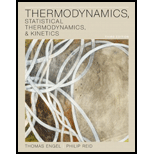
A cylindrical vessel with rigid adiabatic walls is separated into two parts by a frictionless adiabatic piston. Each part contains 45.0 L of an ideal monatomic gas with
- Calculate the work done on the right part in this process and the final temperature in the right part.
- Calculate the final temperature in the left part and the amount of heat that flowed into this part.
Want to see the full answer?
Check out a sample textbook solution
Chapter 2 Solutions
Thermodynamics, Statistical Thermodynamics, & Kinetics
- An automobile wheel contains air with a pressure of 3x105 Pa at 25 ° C. The sipop cover was removed and the air was expanded adiabatically against an external pressure of 105 Pa. What is the final temperature of the gas in the wheel? (Take into account that the gas behaves ideally and the Cp value for air is 7 / 2R)arrow_forwardPhysical chemistry - please refer to pics Now, consider 2.0 moles of methane (CH4 ), initially at 273 K, that is reversibly and adiabatically compressed from an initial volume of 10.00 L to a final volume of 2.00 L. 3a. Determine the final temperature, considering the gas to be described by the ideal gas equation of state. 3b. Determine the work required w, the associated heat flow q, and the internal energy change ∆U for the gas between the initial and final states.arrow_forwardOne mole of a monatomic ideal gas begins in a state withP 5 1.00 atm and T 5 300 K. It is expanded reversiblyand adiabatically until the volume has doubled; then it isexpanded irreversibly and isothermally into a vacuumuntil the volume has doubled again; and then it is heatedreversibly at constant volume to 400 K. Finally, it is compressed reversibly and isothermally until a inal state withP 5 1.00 atm and T 5 400 K is reached. Calculate DSsysfor this process. (Hint: There are two ways to solve thisproblem—an easy way and a hard way.)arrow_forward
- Calculate the final pressure of a sample of water vapour that expands reversibly and adiabatically from 87.3 Torr and 500 cm3 to a final volume of 3.0 dm3. Take (gamma) γ = 1.3. ANs in t0rrarrow_forward. A 2.50 mole sample of a perfect gas for which Cv,m = 3R/2 (assume constant over T-range) undergoes the following two-step process: (1) from an initial state of the gas described by T = 13 ºC and P = 1.75 x 105 Pa, the gas undergoes an isothermal expansion against a constant pressure of 3.75 x 104 Pa until the volume has doubled. (2) subsequently, the gas is cooled at constant volume. The temperature falls to -24ºC. Calculate q, w, ∆U, and ∆H for each step and for the overall process.arrow_forwardCalculate the final temperature when a quantity of nitrogen, originally at 298 K, is compressed reversibly and adiabatically from a volume of 20.0 dm^3 to 5.00 dm^3. Assume ideal behavior and take C_v to be 5R/2arrow_forward
- A sample of 2.2 mol CO2(g) is originally confined in 15 dm3 at 280 K and then undergoes adiabatic expansion against a constant pressure of 78.5 kPa until the volume has increased by a factor of 4.0. Calculate ΔT. (The final pressure of the gas is not necessarily 78.5 kPa.)arrow_forward1. A chemical reaction takes place in a container fitted with a piston of cross-sectional area 75.0 cm2 . As a result of the reaction, the piston is pushed out through 25.0 cm against an external pressure of 150 kPa. Calculate the work done by the system.arrow_forwardConsider one mole of a simple ideal gas enclosed in a cylindrical piston with rigid impermeable adiabatic walls. The piston has a cross sectional area ofA = 0.10 m^2 and the cylinder enclosing the gas has a height of h = 1.0 cm. The gas inside the piston has a temperature T = 300.K. Recall that the internal energy for an ideal gas is U= n cV,mT, where cV,m= 1.5 R is the molar heat capacity for the ideal gas. mass m = 15.3E3kg is placed on the top of the piston, but that the piston top remains rigid. The external pressure applied is 1.5E6 Pa. The equilubrium volume for the gas is 1.6E-3 m^3. Suppose that the piston is now allowed to move within the cylinder, but that the walls remain adiabatic and impermeable so that no heat flows into the gas. The gas system will ultimately move to a new equilibrium state. We will now characterize the final equilibrium state and the changes resulting from the process. Define the (Total System) = (the gas enclosed in the cylinder) plus (the mass placed…arrow_forward
- A sample of nitrogen of mass 3.12 g at 23.0 °C is allowed to expand reversibly and adiabatically from 400 cm3 to 2.00 dm3. What is the work done by the gas?arrow_forwardCalculate the final pressure of a sample of carbon dioxide that expands reversibly and adiabatically from 67.4 kPa and 0.50 dm3 to a final volume of 2.00 dm3. Take γ = 1.4.arrow_forwardCalculate the final temperature of air of mass 3.0kg that is expanding reversibly and adiabatically from 1.0dm³ at 273.15k to 3.0dm³.arrow_forward
 Physical ChemistryChemistryISBN:9781133958437Author:Ball, David W. (david Warren), BAER, TomasPublisher:Wadsworth Cengage Learning,
Physical ChemistryChemistryISBN:9781133958437Author:Ball, David W. (david Warren), BAER, TomasPublisher:Wadsworth Cengage Learning,
